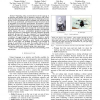Free Online Productivity Tools
i2Speak
i2Symbol
i2OCR
iTex2Img
iWeb2Print
iWeb2Shot
i2Type
iPdf2Split
iPdf2Merge
i2Bopomofo
i2Arabic
i2Style
i2Image
i2PDF
iLatex2Rtf
Sci2ools
114
Voted
HRI
2010
ACM
2010
ACM
Toward understanding natural language directions
—Speaking using unconstrained natural language is an intuitive and flexible way for humans to interact with robots. Understanding this kind of linguistic input is challenging because diverse words and phrases must be mapped into structures that the robot can understand, and elements in those structures must be grounded in an uncertain environment. We present a system that follows natural language directions by extracting a sequence of spatial description clauses from the linguistic input and then infers the most probable path through the environment given only information about the environmental geometry and detected visible objects. We use a probabilistic graphical model that factors into three key components. The first component grounds landmark phrases such as “the computers” in the perceptual frame of the robot by exploiting co-occurrence statistics from a database of tagged images such as Flickr. Second, a spatial reasoning component judges how well spatial relations such ...
HRI 2010 | Human Robot Interaction | Linguistic Input | Natural Language | Unconstrained Natural Language |
Related Content
| Added | 17 May 2010 |
| Updated | 17 May 2010 |
| Type | Conference |
| Year | 2010 |
| Where | HRI |
| Authors | Thomas Kollar, Stefanie Tellex, Deb Roy, Nicholas Roy |
Comments (0)

